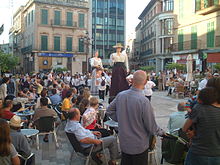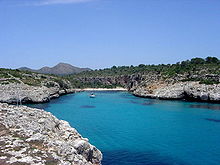- Manacor
-
Manacor — Municipality — 
Flag
Coat of arms
Location in Spain Coordinates: 39°34′0″N 3°12′0″E / 39.566667°N 3.2°ECoordinates: 39°34′0″N 3°12′0″E / 39.566667°N 3.2°E Country  Spain
SpainAutonomous community  Balearic Islands
Balearic IslandsProvince Balearic Islands Island Mallorca Comarca Llevant Judicial district Manacor Government - Alcalde Antoni Pastor Cabrer (2007) (PP) Area - Total 260.31 km2 (100.5 sq mi) Elevation 80 m (262 ft) Population (2008) - Total 39,434 - Density 151.5/km2 (392.4/sq mi) Demonym Manacorense, manacorí Time zone CET (UTC+1) - Summer (DST) CEST (UTC+2) Postal code 07500 Official language(s) Website Official website Manacor (Catalan pronunciation: [mənəˈkɔ]) is a town and municipality on the Mediterranean island of Majorca, part of the Spanish autonomous community of the Balearic Islands. It is one of the biggest municipalities in Majorca. It has tourist areas like Porto Cristo, site of the famous Caves of Drach, and Calas de Mallorca. Manacor has one of the busiest street markets on the island, held every Monday morning. Manacor is famous for furniture manufacture and artificial pearls. It is a terminating station on the Majorca rail network.
Contents
History
The first indications of human occupation in the area of Manacor go back to 2000-1200 BC. Of this period are the artificial coves as burial places (cova de s'Homonet at Son Ribot, Mitjà de ses Beies at Sa Sínia Nova, etc.), and a type of construction similar to the naveta, either isolated or grouped in villages, which were used as living spaces (sa Marineta, s'Hospitalet Vell, etc.)
Of the megalithic Talaiot culture, the most outstanding constructions are s'Hospitalet Vell, es Boc, Bellver, as well as the constructions of Bendrís, Son Sureda and Sa Gruta.
The origin of the town of Manacor goes back to the times before the Islamic dominance. The submarine discoveries of objects found in Porto Cristo show that it was a Roman port. The remains of the basilicas of sa Carrotja and son Peretó prove the existence of well-established Christian communities.
After the invasion launched by James I of Aragon, Nuño Sánchez received from him the land of Manacor. In 1300, James II granted Manacor a statute of municipality. The Torre del Palau and the fortification of some rural houses like the Torre de ses Puntes and the Torre dels Enagistes have been preserved from the beginnings of town planning at Manacor. A native of Manacor, Simó Tort, was a character in medieval social conflicts.
Saint Vincent Ferrer came to Manacor in 1414. In 1576 the convent dedicated to the saint was founded, and after this the construction of the baroque church began. At the beginning of the following century the construction of the cloister began.
In 1879 the railroad line from Inca to Manacor was opened. About 1890 the construction of the new parish church Nostra Senyora dels Dolors began, located on the same place as the former churches. The most ancient of them had been documented in 1232 and had possibly been built upon an Arab mosque. The bell tower of the present church, an emblem of the town, measures 75 metres. In 1897 the first factory of artificial pearls, the famous Majorica, was founded. So Manacor became the business and industrial centre of Llevant. In 1912 Manacor received the title of town.
In 1936, during the Spanish Civil War, there was an attempted landing of Republican forces in the shores of Porto Cristo that was repelled by the Nationalists.
Geography
The relief is not very pronounced. It takes in three areas: the flat region of the Pla, where the town of Manacor stands; the Serra de Llevant, characterised by its soft relief; and the Marina, which is formed by white gritty stone and inclines down to the sea. These limestone karsts have favoured the appearance of caves. The most outstanding for their beauty are the Cavern of the Dragon and the Fishhook Caves.
A wide range of coves embellish the coast of Manacor: s'Illot, Cala Morlanda, Cala Petita, Porto Cristo, Cala Anguila, Cala Mendia, s'Estany d'en Mas, Cala Falcó, Cala Varques, Cala Sequer, Cala Magraner, Cala Pilota, Cala Virgili, Cala Bota, Cala Antena, Cala Domingos and Cala Murada.
The climate is Mediterranean. The average annual temperature is in between 16º - 17°C.
The forest area represents little more than 20% of the whole. Pine forest is found in the mountainous areas but there are hardly any survivals of the indigenous holm-oak woodlands.
The cultivated land represents 74% of the area. The agricultural landscape is characterized by almond trees, cereals, fig trees, carob trees and vineyard. The cultivation of vegetables is focused on melon, pepper and lettuce.
The town of Manacor is crossed by the Sa Cabana stream. This stream flows into the Na Borges stream, the most important of the municipality.
Demographics
Municipality Population 16th century 5.000 approx. 18th century 7.000 approx. Beginnings of 20th century 13.000 approx. Centers Population 2005 Manacor 25.324 Porto Cristo 6.385 S'Illot-Cala Morlanda 1.576 Son Macià 839 Cales de Mallorca 725 Cala Murada 624 Cala Anguila-Cala Mendia 296 S'Estany den Mas 139 Total 35.908 Economy
Until the 19th century the economy of Manacor was based on agriculture (cereals and vineyard) and livestock (sheep), although the textile and food sectors as well as pottery were important too. Although there are no longer the large estates that there were at that time, there are some that maintain their antique splendor, such as Santa Cirga and Es Fangar (the largest).
The 19th century marked the beginning of the transformation of the town. The industrial activities dedicated to the processing of agricultural product increased; windmills and a liquor distillery appeared. From the second half of the century on the production of furniture became one of the basic industries of Manacor. Pottery and the production of liquors and wines also continued.
The factory of artificial pearls was very important during the 20th century.
From the 1960s, tourism was added to the development of the economic activity of the municipality.
Construction is an important sector, as well as commerce.
Culture
Sant Antoni
The celebration begins with the exit of a group of disguised men of Saint Anthony, the greater Demon and several smaller demons, on the eve of the 17 of January. They cross the streets performing a dance that represents the temptations to which the saint was submitted. At night bonfires are ignited. The group visit the several bonfires of the municipality. People sing and dance, and eat "llangonisses" and "botifarrons" (typical pork products of the island).
On the following day are celebrated the "Beneïdes", a parade of floats and animals of all type. They are blessed because the saint is the patron of the animals.
Fairs
The most important are the Fires i Festes de Primavera. They are celebrated from the end of May to the beginning of June. During these days, they are many activities and exhibitions. The celebrations close with a great parade of floats.
Other fairs : Fair of Saint James, patron of Manacor, the 25 July, and the September Fair.
Theatre
Manacor has an important theatre season, the Fira del Teatre de Manacor, usually in September.
Moratons
This is a ritual dance of uncertain origin. It seems that was composed around the year 1855 with religious reasons, but it is possible that its origin goes back to 16th century. The clothes of the Moretons looked like those of Barbary pirates. When they dance, they hit wood pieces located in the hands, knees and abdomen.
Els Moretons go out in May, by the Sant Domingo celebrations.
Cossiers
There are documents about this ritual dance from 18th century. The cossiers are a group of men who dance around a woman known as "The Lady". They wear hat and coloured clothes.
Nowadays, they open the Fires i Festes de Primavera.
Vimer
This has been a legend for more than 100 years. The vimer (Salix viminalis) is a willow located in s'hort des Correu, a country house in the outskirts of the town of Manacor. The legend says that the tree can heal children with hernia. For this, they are passed through the branches of the tree, when the sun rises on the Saint John's Day, the 24th of June.
Gastronomy
A typical product is sospiros.
Sports
In addition to the main sports, soccer and basketball, Manacor has horse racing fans and there are chariot races at the hippodrome. Manacor is also the birthplace and home town of former World Tennis number 1 Rafael Nadal.
Natives of Manacor
- Antoni Maria Alcover
- Miguel Ángel Nadal
- Elena Gómez
- Luis Ladaria
- Rafael Nadal
- Arnau Riera
- Albert Riera
References
Municipalities in the Balearic Islands Majorca Alaró · Alcúdia · Algaida · Andratx · Ariany · Artà · Banyalbufar · Binissalem · Búger · Bunyola · Calvià · Campanet · Campos · Capdepera · Consell · Costitx · Deià · Escorca · Esporles · Estellencs · Felanitx · Fornalutx · Inca · Lloret de Vistalegre · Lloseta · Llubí · Llucmajor · Manacor · Mancor de la Vall · Maria de la Salut · Marratxí · Montuïri · Muro · Palma · Petra · Sa Pobla · Pollença · Porreres · Puigpunyent · Ses Salines · Sant Joan · Sant Llorenç des Cardassar · Santa Eugènia · Santa Margalida · Santa Maria del Camí · Santanyí · Selva · Sencelles · Sineu · Sóller · Son Servera · Valldemossa · Vilafranca de Bonany
Minorca Ibiza Formentera Categories:- Manacor
- Populated places in Majorca
Wikimedia Foundation. 2010.







